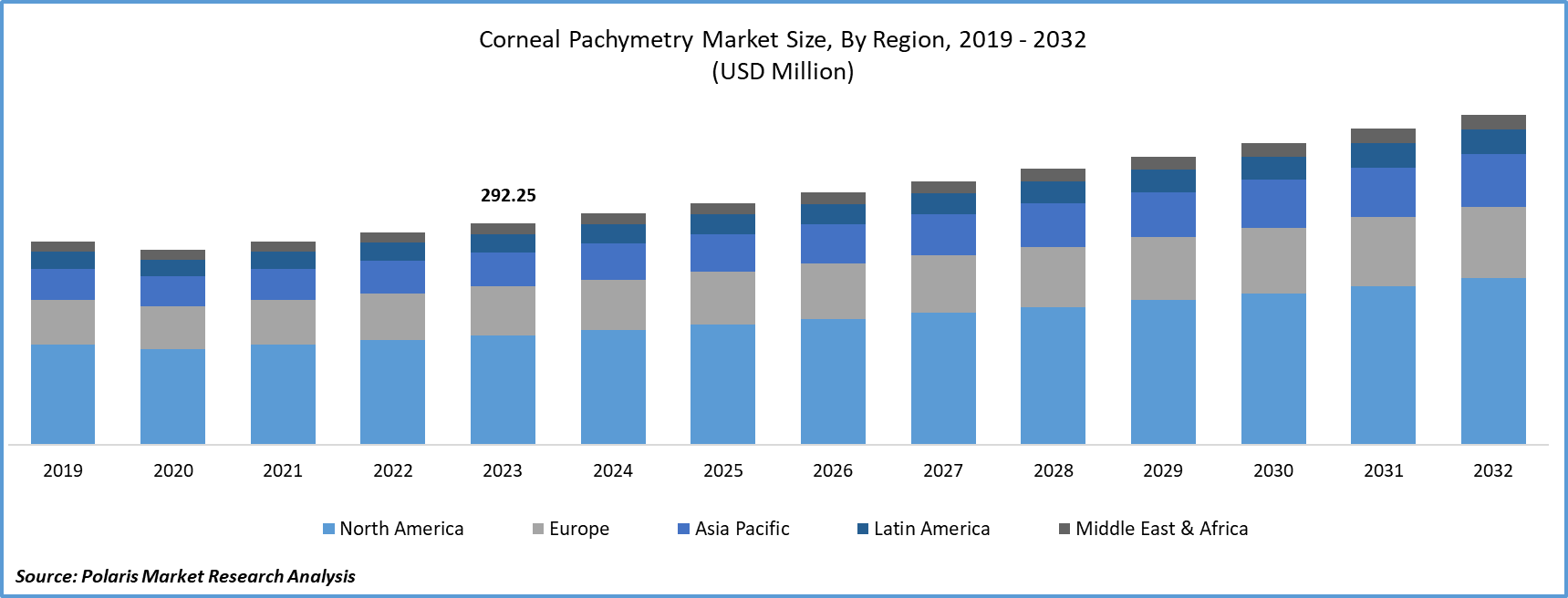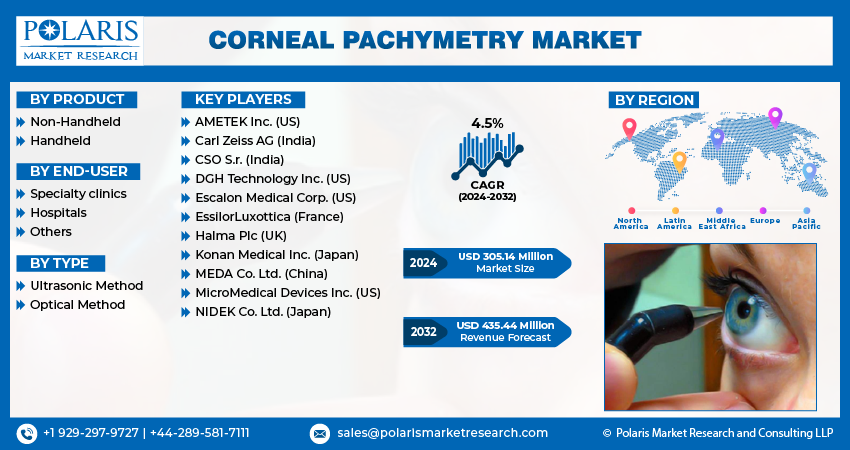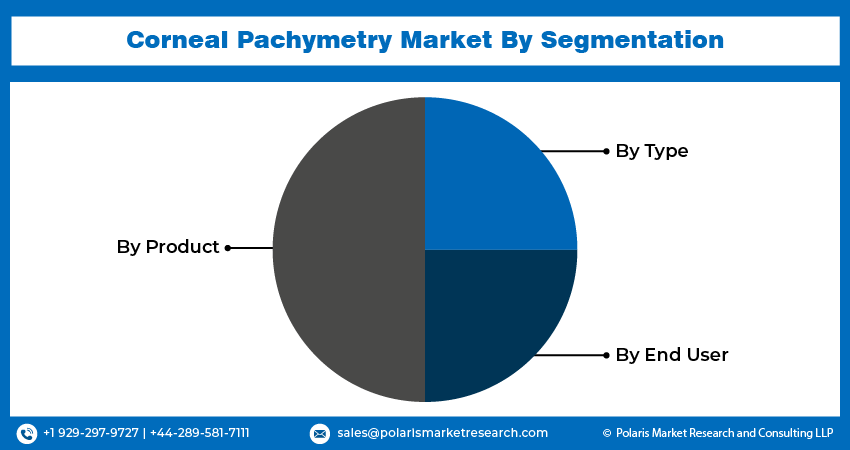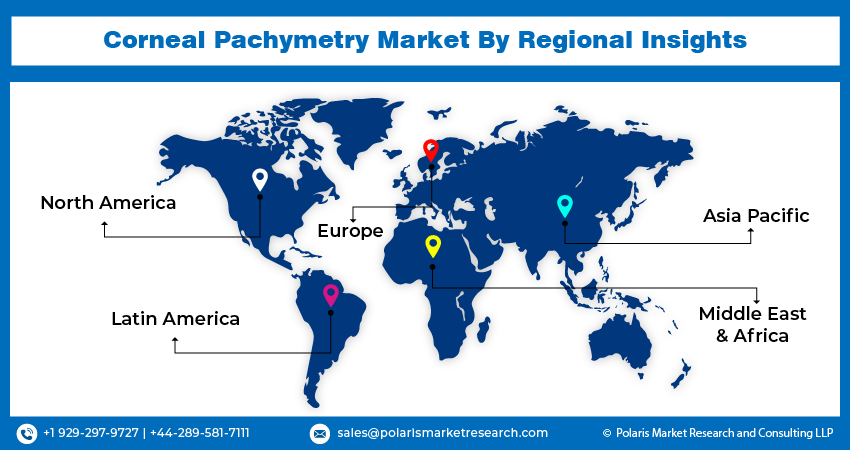
Corneal Pachymetry Market Share, Size, Trends, Industry Analysis Report, By Product (Non-Handheld, Handheld); By End-user; By Type; By Application; By Region; Segment Forecast, 2024 - 2032
- Published Date:Mar-2024
- Pages: 114
- Format: PDF
- Report ID: PM4782
- Base Year: 2023
- Historical Data: 2019-2022
Report Outlook
Global corneal pachymetry market size was valued at USD 292.25 million in 2023. The market is anticipated to grow from USD 305.14 million in 2024 to USD 435.44 million by 2032, exhibiting the CAGR of 4.5% during the forecast period.
Market Overview
The corneal pachymetry market has witnessed significant growth in recent years due to advancements in ophthalmic diagnostic technologies and an increasing prevalence of corneal diseases and disorders worldwide. Corneal pachymetry, a non-invasive procedure for measuring corneal thickness, plays a crucial role in the diagnosis and management of conditions such as glaucoma, corneal ectasia, and refractive surgeries like LASIK. The market encompasses various devices and equipment used for measuring corneal thickness, including ultrasound pachymetry, optical coherence tomography (OCT), and Scheimpflug imaging systems.

To Understand More About this Research: Request a Free Sample Report
One of the primary driving factors behind the growth of the corneal pachymetry market is the rising incidence of eye disorders globally. Conditions such as glaucoma, which often require regular monitoring of corneal thickness, have become increasingly prevalent due to aging populations and lifestyle factors. Additionally, the growing demand for refractive surgeries, such as LASIK and photorefractive keratectomy (PRK), has boosted the adoption of corneal pachymetry devices for pre-operative assessments and post-operative follow-ups.
Technological advancements in corneal pachymetry devices have also contributed to market growth. Manufacturers are continuously innovating to develop more accurate, user-friendly, and portable devices, enhancing the efficiency and reliability of corneal thickness measurements. Integration of advanced imaging technologies, such as OCT and Scheimpflug imaging, has enabled clinicians to obtain detailed corneal thickness maps with higher precision and resolution, facilitating better diagnosis and treatment planning.
Growth Drivers
Rising awareness about corneal diseases
The rising awareness about several health problems with the increased knowledge about the symptoms and health conditions with the enhanced access to the internet. The growing initiatives to promote early detection of eye-related health complications by healthcare providers are likely to assist in detection, facilitating the demand for corneal pachymetry in the long run. For instance, in January 2023, GROW laboratory researchers introduced a diagnostic kit to predict, diagnose, and manage keratoconus, ocular inflammation, dry eye, and more.
Increase in the adoption of Lasik surgery
Most people in the world are showing profound interest in adopting laser treatment and removing spectacles. This is forcing the government to step in and create a diverse healthcare infrastructure for the common people. For instance, in November 2023, a Lasik center was launched at the command hospital in Lucknow with the rising demand for Lasik surgeries. As more centers establish themselves to tackle blindness, there will be a significant demand for corneal pachymetry in the global market.
The presence of a strong consumer base choosing laser surgeries is likely to bolster market growth. In 2020, around 637,000 laser operations were performed worldwide, of which 51% and 14% were in the United States and Europe, respectively.
Restraining Factors
The limited availability of health insurance schemes is likely to impede market growth.
The Corneal Pachymetry Market faces significant challenges due to the limited availability of health insurance schemes, which restricts patient access to essential diagnostic procedures. Corneal pachymetry, a vital tool in ophthalmic diagnostics, measures the thickness of the cornea, aiding in the diagnosis and management of various eye conditions, including glaucoma and keratoconus. However, the high cost associated with corneal pachymetry tests poses a substantial barrier to access for many patients, particularly in regions with limited health insurance coverage. This constraint not only affects individuals seeking routine eye examinations but also impacts those requiring specialized care for ocular conditions. Consequently, the restricted accessibility to corneal pachymetry tests hinders early detection and timely intervention, potentially exacerbating vision-related complications and increasing healthcare burdens.
Moreover, the Corneal Pachymetry Market encounters restraining factors stemming from the complex regulatory landscape surrounding medical devices and diagnostics. Stringent regulatory requirements, varying across different jurisdictions pose challenges for market players seeking to introduce innovative pachymetry technologies or expand their market presence. Compliance with regulatory standards necessitates substantial investments in research, development, and regulatory approvals, prolonging product launch timelines and escalating operational costs. Furthermore, navigating diverse regulatory frameworks demands extensive expertise and resources, presenting formidable barriers to entry for new entrants and constraining market growth potential.

Report Segmentation
The market is primarily segmented based on product, end-user, type, application and region.
|
By Product |
By End-user |
By Type |
By Region |
|
|
|
|
To Understand the Scope of this Report: Speak to Analyst
By Product Analysis
Non-Handheld segment is expected to witness the highest growth during the forecast period
The non-handheld segment will grow rapidly during the forecast period, driven by its non-invasiveness and ability to capture accurate eye movements in a limited time. The capability of non-handheld corneal pachymetry devices to lower user errors is driving the demand for these medical tests in the marketplace. This medical test is considered safer, quicker, and simpler, with a lower risk of infection transmission among individuals.
The handheld segment led the market with a substantial revenue share in 2023, largely attributable to its ability to provide reliable statistics of corneal thickness in the central and peripheral regions of the eye. This device is gaining momentum because it can assist in glaucoma management by screening abnormalities of corneal thickness.
By End-user Analysis
Speciality clinics segment accounted for the largest market share in 2023
The specialty clinics segment accounted for the largest market share in 2023 and is likely to retain its market position throughout the forecast period. The higher segmental growth of specialty clinics is highly influenced by the rising establishment of new eye care hospitals offering treatment for glaucoma and other eye diseases. This is encouraging people to visit specialty clinics for eye-related health issues, creating the need for corneal pachymetry in the global market.
By Application Analysis
Glaucoma diagnosis segment is anticipated to register a dominant share in the study period
The glaucoma diagnosis segment is expected to witness a dominant share in the marketplace during the forecast timeframe, attributable to the rising government initiatives to promote awareness and early detection of glaucoma in the marketplace. The necessity of the corneal pachymetry test to monitor the glaucoma condition among patients is anticipated to boost market growth in the forecast period.

Regional Insights
North America region registered the largest share of the global market in 2023
The North American region dominated the market in 2023. The region’s growth is due to the higher rate of glaucoma and refractive surgeries. The availability of superior healthcare medication infrastructure in the region is optimally driving global corneal pachymetry market growth. According to the National Eye Institute, the prevalence of glaucoma cases is projected to grow by 58%, reaching 4.2 million by 2030. This will further drive the importance of corneal thickness medical tests in the region in the upcoming years.
The Asia Pacific is expected to grow rapidly, owing to the growing prevalence of a higher number of glaucoma cases, primarily in India. The worldwide cases of glaucoma in 2020 registered around 76 million, while India accounts for a 20% share at the global level. The presence of a geriatric population in the region is anticipated to create a huge demand for certain medical testing technologies, including corneal pachymetry, in the long run.

Key Market Players & Competitive Insights
The corneal pachymetry market is fragmented in nature, with the existence of several market players with a smaller global market share and ongoing expansion activities, primarily partnerships. For instance, in July 2023, Occuity, a medical technology company, signed a distributor partnership agreement with the UK and Europe before the launch of its PM1 Pachymeter into the market.
Some of the major players operating in the global market include:
- AMETEK Inc. (US)
- Carl Zeiss AG (India)
- CSO S.r. (India)
- DGH Technology Inc. (US)
- Escalon Medical Corp. (US)
- EssilorLuxottica (France)
- Halma Plc (UK)
- Konan Medical Inc. (Japan)
- MEDA Co. Ltd. (China)
- MicroMedical Devices Inc. (US)
- NIDEK Co. Ltd. (Japan)
Recent Developments in the Industry
- In March 2023, Occuity unveiled its new corneal thickness medical test, the PM1 Pachymeter, a non-contact handheld contact device, along with the AX1 Axiometer prototype for myopia control.
Report Coverage
The corneal pachymetry market report emphasizes on key regions across the globe to provide better understanding of the product to the users. Also, the report provides market insights into recent developments, trends and analyzes the technologies that are gaining traction around the globe. Furthermore, the report covers in-depth qualitative analysis pertaining to various paradigm shifts associated with the transformation of these solutions.
The report provides detailed analysis of the market while focusing on various key aspects such as competitive analysis, product, end-user, type, application and their futuristic growth opportunities.
Corneal Pachymetry Market Report Scope
|
Report Attributes |
Details |
|
Market size value in 2024 |
USD 305.14 million |
|
Revenue forecast in 2032 |
USD 435.44 million |
|
CAGR |
4.5% from 2024 – 2032 |
|
Base year |
2023 |
|
Historical data |
2019 – 2022 |
|
Forecast period |
2024 – 2032 |
|
Quantitative units |
Revenue in USD million and CAGR from 2024 to 2032 |
|
Segments covered |
|
|
Regional scope |
|
|
Competitive Landscape |
|
|
Report Format |
|
|
Customization |
Report customization as per your requirements with respect to countries, region and segmentation. |
FAQ's
The Corneal Pachymetry Market report covering key segments are product, end-user, type, application and region.
Corneal Pachymetry Market Size Worth $435.44 Million By 2032
Corneal Pachymetry Market exhibiting the CAGR of 4.5% during the forecast period.
North America is leading the global market
key driving factors in Corneal Pachymetry Market are Rising awareness about corneal diseases
